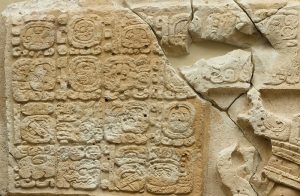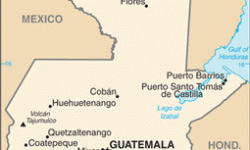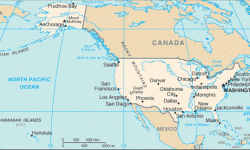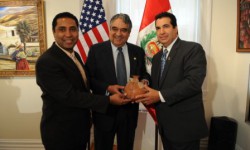El Perú-Waka’ Stela Fragment Returned to Guatemala in 1999
Author: Donna Yates
Last Modified: 10 Apr 2025

Maya sculpture stolen from a Guatemalan site and recovered from Sotheby’s auction house
[Image: (CC 0, Wikimedia commons) Detailed view of a different looted stela from El Perú-Waka’ now in the Cleveland Museum.]
The Maya site of El Perú-Waka’ is located in the Petén Department of Guatemala, within the Laguna del Tigre National Park, part of the Maya Biosphere Reserve. It was discovered in the 1960s by petroleum exploitation workers (Rich and Navarro-Farr, 2014: 4). Originally called “El Perú”, the subsequent decipherment of Maya writing has confirmed that the city was originally called Waka’, perhaps meaning something like Centipede Water or just Centipede City (Guenter 2014), leading to the hyphenated “El Perú-Waka'” which is commonly used by archaeologists. El Perú-Waka’ is located 115 km southwest of Calakmul and 72 km west of Tikal, the two major warring polities during the lowland Maya Classic period (Rich and Navarro-Farr 2014: 4).
In 1971, archaeologist Ian Graham mapped and recorded the centre of El Perú-Waka’ as part of the Maya Hieroglyphic Inscriptions programme supported by Harvard University; he recorded around 660 architectural features in an area of less than 1 square kilometre (Rich and Navarro-Farr 2014: 6). Among the features Graham recorded were 39 stela (Guenter 2014: 147), and more stela have since been located at the site and recorded. It was clear that looters had reached El Perú-Waka’ before archaeologists. Graham later stated that he “got there six years too late” and that looters “really trashed the site” (Graham, quoted in Shim 1999).
Among the stela that Graham recorded was one that had been distinctively cut by looters. Only one piece of the stela was missing, a fragment that formed part of the chest ornament of the stela’s central figure (Archaeology 1999). The fragment measured 30 cm by 60 cm (Cabral 1999), and had been removed with saws, leaving a flat place in the centre of the sculpture (Gardiner 1999). Graham believed that the fragment had been stolen within the previous 5 years, so after about 1965 (Gardiner 1999).
Graham took detailed photographs and measurements of the remaining portions of the stela, actions that would lead to a positive identification of the missing piece (Herrick, Feinstein LLP, n.d.). Also, because of the regularity of Maya iconography, Graham noted that he “could guess pretty much what the design was” on the piece that had been stolen (Gardiner 1999). In other words, if the piece ever appeared on the market, Graham would be prepared to identify it. This is what happened 27 years later.
In the autumn of 1998 the unnamed American possessor of the stela fragment offered it for sale at Sotheby’s auction house in New York City. The sale was brought to Graham’s attention, who confirmed that the fragment was the missing piece from the El Perú-Waka’ stela he recorded in 1971 (Herrick, Feinstein LLP, n.d.). Graham contacted the Guatemalan Consulate in New York with his concerns who contacted their lawyers in the US; the lawyers then contacted the US Customs Service who opened an investigation (Herrick, Feinstein LLP, n.d.).
Archaeology Magazine (1999) reported that Sotheby’s “suspected the stela fragment was hot” and advised the possessor to return the piece to Guatemala rather than face the risk of possible legal action. Other sources indicate that it was Guatemala’s lawyer, Howard Spiegler, who suggested the return to the possessor (Gardiner 1999; Shim 1999). The possessor chose to voluntarily return the fragment which was given to Guatemala in mid-1999 while remaining anonymous (Archaeology Magazine 1999; Gardiner 1999; Herrick, Feinstein LLP, n.d.).
It is unclear what happened to the stela fragment between its looting in the 1960s and its reappearance in the United States in the late 1990s.
At the time of writing (mid 2023), Graham’s notes about El Perú-Waka’ are not yet available online and we have not yet located a source that confirms what stela number the fragment corresponds to. We welcome that information, please contact us.
Works Cited
Archaeology Magazine (1999) Maya Stela Fragment Returned. Archaeology Magazine. 3 September. https://archive.archaeology.org/online/news/stela.html
Cabral, Elena (1999) ‘Indiana Jones’ helps in return of 1,000-year-old Mayan relic. The Record. 7 August.
Gardiner, Beth (1999) Stolen Mayan artifact returned to Guatemalan authorities. Associated Press. 4 August.
Guenter, Stanley Paul (2014) “The Epigraphy of El Perú-Waka'” In Archaeology at El Perú-Waka’: Ancient Maya Performances of Ritual, Memory, and Power. Olivia C. Navarro-Farr and Michelle Rich (Eds). University of Arizona Press
Herrick, Feinstein LLP (n.d.) Guatemala Announces Recovery of Thousand Year Old Stone Figure. Press Release. Available at: https://www.herrick.com/content/uploads/2016/01/bd7ea8dc8534d0a14391044e5895dc52.pdf
Rich, Michelle and Olivia C. Navarro-Farr (2014) “Introduction: Ritual, Memory, and Power Among the Maya and at Classic Period El Perú-Waka'”. In Archaeology at El Perú-Waka’: Ancient Maya Performances of Ritual, Memory, and Power. Olivia C. Navarro-Farr and Michelle Rich (Eds). University of Arizona Press.
Shim, Maria S. (1999) Harvard Archaeologist Identifies Stolen Mayan Artifact. The Harvard Crimson, 13 August.



